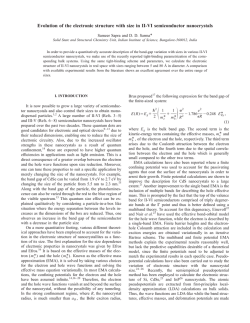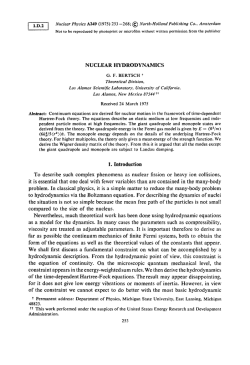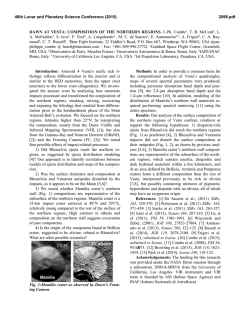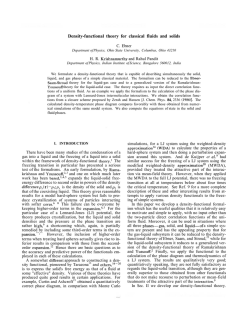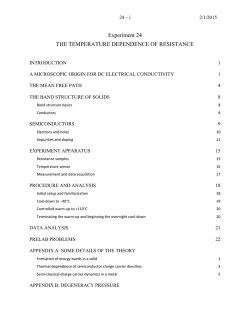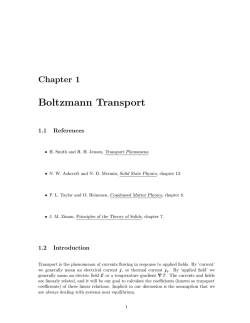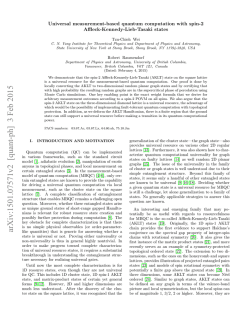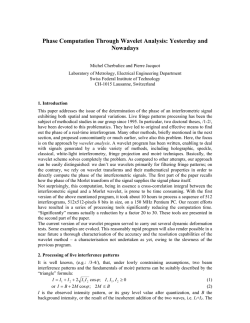
PDF (1.07 MB)
Home Search Collections Journals About Contact us My IOPscience First-principles Study of Structural Properties of MgxZn1-xO ternary alloys This content has been downloaded from IOPscience. Please scroll down to see the full text. 2015 J. Phys.: Conf. Ser. 574 012169 (http://iopscience.iop.org/1742-6596/574/1/012169) View the table of contents for this issue, or go to the journal homepage for more Download details: IP Address: 136.243.24.42 This content was downloaded on 06/02/2015 at 15:20 Please note that terms and conditions apply. IC-MSQUARE 2014 Journal of Physics: Conference Series 574 (2015) 012169 IOP Publishing doi:10.1088/1742-6596/574/1/012169 First-principles Study of Structural Properties of MgxZn1-xO ternary alloys J. Gao, G. J. Zhao, X. X. Liang and T. L. Song Department of Physics, School of Physical Science and Technology, Inner Mongolia University, Hohhot 010021, P. R . China Email: [email protected] Abstract. First-principles calculations have been carried out to investigate the structural and electronic properties of MgxZn1-xO ternary alloys. The calculations are performed using the full potential linearized augmented plane wave (FP-LAPW) method within the density functional theory(DFT). We conclude that the structural properties of these materials, in particular the composition dependence on the lattice constant and the band gap is found to be linear. The a-axis length in the lattice gradually increases, while the c-axis length decreases with the increase in Mg doping concentration, and be corresponded with the Vegard’s law linear rule. The lattice parameters of the MgxZn1-xO ternary alloys are consistent with experimental data and other theoretical results. We found in the conduction band portion, the Mg 2p 2s states are moved to high energy region as the Mg content increases, so the band gap increases. 1. Introduction During the past few years, the II-VI compound semiconductors have received considerable interest from both experimental and theoretical points of view. This is due to their potential technological applications in light-emitting diodes (LEDs) and laser diodes (LDs)[1]. As a typical II-VI wide-gap semiconductor and oxide, ZnO have been of growing interest and have shown great potential in ultraviolet photoelectric devices application, especially in deep ultraviolet light emitters and detectors application, because of its wide band gap(3.37eV) and large exciton binding energy (60 meV) at room temperature[2-3]. It has wide range of technological applications such as transparent conducting[4] electrodes in solar cells and flat panel displays, surface acoustic wave devices and gas sensors[5-7]. All the time, there are two important requirements in fabricating ZnO laser diodes are p-type doping and band gap engineering in alloy semiconductors to create barrier layers and quantum wells which facilitate radiative recombination by carrier confinement. The addition of impurities among the wide band gap semiconductors often induces dramatic changes in their structural and optical properties. Ternary MgxZn1−xO compounds are ideal materials for the development of deep ultraviolet photoelectric devices because they have many particular advantages, such as availability of lattice-matched single-crystal substrates, wide tunable band gap(3.3 to 7.8eV), low growth temperature (100-750 °C), high radiation hardness[8-9]. In addition, because the ionic radius of Mg2+(0.57Å) is similar to that of Zn2+(0.60Å), Zn can be substituted by Mg without much lattice distortion[10], Furthermore, the bonding strength of Mg-O is stronger than that of Zn-O, therefore MgZnO is expected to have higher lattice stability than ZnO. Moreover, the accomplishment of UV LEDs based on MgZnO has been demonstrated very recently[11]. Content from this work may be used under the terms of the Creative Commons Attribution 3.0 licence. Any further distribution of this work must maintain attribution to the author(s) and the title of the work, journal citation and DOI. Published under licence by IOP Publishing Ltd 1 IC-MSQUARE 2014 Journal of Physics: Conference Series 574 (2015) 012169 IOP Publishing doi:10.1088/1742-6596/574/1/012169 In order to understand the nature of these materials better we present the results of first-principles calculations of ternary alloys MgxZn1-xO in wurtzite structure. In this work, we study the electronic and structural properties of MgxZn1-xO ternary alloys in wurtzite phase over a wide range of compositions 0≤x≤1 using the full potential linearized augmented plane wave (FP-LAPW) method within the density functional theory. 2. Calculation Method The calculations presented in this work were performed using first-principles, plane-wave pseudopotential approach within the framework of density-functional theory(DFT) implemented in the Cambridge Serial Total Energy Package(CASTEP) codes[12]. For the exchange-correlation potential, we used the generalized gradient approximation(GGA) of Perdew and Wang, known as PW91[13]. The plane-wave cutoff energy is set to be 400eV in the present calculations. The special points sampling integration over the Brillouin zone is employed by using the Monkhorst-Pack method [14] with a 4×4×5 special k-point mesh. The Mg 2p63s2, Zn 3d104s2 and O 2s22p4 electrons are treated as valence states. The Brodyden-Fletcher-Goldfar-Shanno(BFGS) minimization scheme[15] was used in geometry optimization. The tolerances for geometry optimization were set as the difference in total energy being within 2×10-5eV/atom, the maximum ionic Hellmann-Feynman force within 0.05eV/Å, the maximum ionic displacement within 0.002Å and the maximum stress within 0.1GPa. Figure 1 depicts the schematics of MgxZn1-xO alloys. Figure1. The crystal structure of wurtzite MgxZn1-xO alloys. 3. Results and discussions 3.1 Structural properties In the present work, we model the alloys at some selected compositions with the ordered structures described in terms of periodically repeated supercells with sixteen atoms per unit cell. For the considered structures, we perform the structural optimization by minimizing the total energy with respect to the cell parameters and also the atomic positions. Our calculated values for the equilibrium lattice constants for MgxZn1-xO alloys are given in Table 1. Usually, in the treatment of alloy problems, it is assumed that the atoms are located at ideal lattice sites and the lattice constants of alloys should vary linearly with compositions x according to the so-called Vegard’s law[16]. So the lattice constant of ternary MgxZn1-xO alloys can be expressed by Vegard’s law. (1) a ( Mg x Zn1− x O ) = xaMgO + (1 − x ) aZnO Figure 2 shows the variation of the calculated equilibrium lattice constants versus concentration for MgxZn1-xO alloys. From the figure 2 we can conclude that the a-axis length in the lattice gradually increases, while the c-axis length decreases with increasing Mg content, consistent with experimental results and other theoretical results[17]. The linear equation of lattice parameter a and c are obtained 2 IC-MSQUARE 2014 Journal of Physics: Conference Series 574 (2015) 012169 IOP Publishing doi:10.1088/1742-6596/574/1/012169 using the linear fitting method. We reach the conclusion that the results are very close to that of other papers’ conclusion [18]. a = 3.28162 + 0.06653x (2) c = 5.31564 − 0.15373x Table 1. Calculated lattice parameter a and c for ZnO(WZ) and MgO(RS) and their alloys at equilibrium volume. Compared with other theoretical calculations and experimental results. Lattice constant a (Å) x This work Exp. Other calculations This work 0 3.280 3.249c 3.280a 5.280 0.125 3.275 b 3.297 b 3.295 0.375 3.303 3.313 b 0.5 3.308 0.625 3.324 3.325 b 0.75 3.327 0.875 3.337 3.333 b 3.359 Exp. 5.206c Other calculations 5.296a 5.270b 3.291 0.25 1 5.291 5.248b 5.288 5.269 5.22b 5.275 5.218 5.203b 5.215 5.191 5.175b 5.119 Ref [19], bRef [17], cRef [20] Lattice parameter c (Å) Lattice parameter a (Å) a Lattice constant c (Ǻ) Mg content x Mg content x Figure 2. Calculated equilibrium lattice constants of MgxZn1-xO alloys for different Mg concentrations. 3.2. Electronic properties 3.2.1. Band structures We have calculated the energy band for the MgxZn1-xO alloys along the high directions in the first Brillouin zone at the calculated equilibrium lattice constants. Figure 3 shows the variation of band gap with Mg content in hexagonal MgxZn1−xO crystals with 0 ≤ x ≤ 1. In fact, it is well known that the GGA usually underestimates the experimental energy band gap and this is an intrinsic feature of the density functional theory (DFT), DFT being a ground-state theory is not suitable for describing 3 IC-MSQUARE 2014 Journal of Physics: Conference Series 574 (2015) 012169 IOP Publishing doi:10.1088/1742-6596/574/1/012169 Band gap (eV) excited-state properties, such as the energy gap. However, it is widely accepted that GGA (LDA) electronic band structures are qualitatively in good agreement with the experiments as regards the ordering of the energy levels and the shape of the bands. Mg content x Figure 3. Composition dependence of the calculated band gap for MgxZn1−xO alloys. From the Figure 3 we found that with the increase of components the energy gap of the alloys is also increased, it is clearly seen that the calculated band gap exhibits strong composition dependence for MgxZn1−xO alloys. This is different from conventional III-V alloys which show a weakly compositional dependent energy gap. 3.2.2. Density of states We also calculated the partial and total density of states(DOS) of MgxZn1−xO in the WZ structures. Due to the close similarity between the results obtained for these alloys, the DOS is given only for theMg0.75Zn0.25O compound as shown in Figure 4. From the partial DOS, we find that the anion (O) s states are strongly localized in the energy range from -17eV to -15eV and the upper valence band is derived mainly from the hybridization of Zn d and O p states. In the conduction band, the Mg, Zn and O states become partially occupied, while the conduction band is mainly dominated by cation states (Mg). In order to interpret the effect of Mg on the electronic structure, we have offered the changing curve of the density of states with different concentration. It clearly indicates that in the conduction band portion the Mg 2p 3s states are moved to high energy region as the Mg content increases, and the Mg 2p state is more and more dominant in Figure 5. Therefore it leads to an increase in the band gap. 4. Conclusions In this study, we have presented a complete theoretical analysis of the structural and electronic properties of MgxZn1−xO alloys by the first-principles density functional calculations. The structural parameters of MgxZn1−xO alloys are fully relaxed and have been optimized. The calculated results show the calculated lattice constants scale linearly with composition, showing the validity of Vegard’s linear rule in the definition of lattice constants of MgxZn1−xO alloys. We have investigated the composition dependence of the lattice constant and band gap. It can be expected that some of our calculated results will be useful for the device applications of MgxZn1−xO alloys and can be verified in the future experiments. 5. Acknowledgments 4 IC-MSQUARE 2014 Journal of Physics: Conference Series 574 (2015) 012169 IOP Publishing doi:10.1088/1742-6596/574/1/012169 Density of states (states/eV) One of the authors (J. Gao) is supported by the Foundation of enhancing comprehensive strength project of Inner Mongolia University(No.14020202), and the research is supported in part by the PhD Progress Foundation of Higher Education Institutions of China(20111501110003), Natural Science Foundation of Inner Mongolia (No.2011MS0105) and Talent Development Foundation of Inner Mongolia. Energy (eV) Density of states (states/eV) Figure 4. The partial density of states of MgxZn1−xO with x = 75%. The position of Fermi level is located at 0 eV. Energy (eV) Figure 5. The partial density of states of Mg 2p(dashed line), 3s(solid line) bands in hexagonal MgxZn1−xO crystals(x = 0.125, 0.375, 0.5, 0.625, 0.75, 0.875 respectively). References [1] Li X P, Zhang B L, Zhu H C, Dong X, Xia X C, Cui Y G, Ma Y and Du G T 2008 J. Phys. D: Appl. Phys. 41 035101 [2] Ko H J, Chen Y F, Zhu Z, Yao T, Kaobayyashi I and Uchiki H 2000 Appl. Phys. Lett. 76 1905 [3] Park W I, Jun Y H and Jung S W 2003 Appl. Phys. Lett. 82 964 [4] Zhao Q, Zhang H Z, Zhu Y W, Feng S Q, Sun X C, Xu J 2005 Appl. Phys. Lett. 86 203115 [5] Wong L M, Chiam S Y, Huang J Q, Wang S J 2010 J. Appl. Phys. 108 033702 [6] Liao L, Lu H B, Li J C, Liu C 2007 Appl. Phys. Lett. 91 173110 5 IC-MSQUARE 2014 Journal of Physics: Conference Series 574 (2015) 012169 [7] [8] [9] [10] [11] [12] [13] [14] [15] [16] [17] [18] [19] [20] IOP Publishing doi:10.1088/1742-6596/574/1/012169 Ahn M W, Park K S,Heo J H, Park J G, Kim D W and Choi K J 2008 Appl. Phys.Lett. 93 263103 Hierro A , Tabares G, Ulloa J M , Muñoz E, Nakamura A, Hayashi T, Temmyo J 2009 Appl. Phys. Lett. 94 232101 Ghosh R, Basak D J 2007 Appl. Phys. 101 113111. Ku C J, Duan Z Q, Reyes P I, Lu Y C, Xu Y 2011 Appl. Phys. Lett. 98 123511 Nakahara K, Akasaka S, Yuji H and Tamura K 2010 Appl. Phys. Lett. 97 013501 Payne M C, Teter M, Allan D C and Joannopoulos J D 1992 Rev. Mod. Phys. 64 1045 Perdew J P, Chevary J A, Vosko S H, Jackson K A, Pederson M R, Singh D J and Fiolhais C 1992 Phys. Rev. B 46 6671 Monkhorst H J and Pack J D 1976 Phys. Rev. B 13 5188 Fischer T H and Almlof J 1992 J. Phys. Chem. 96 9768 Denton A R and Ashcrof N W 1991 Phys. Rev.A 43 3161 Chang Y S, Chien C T, Chen C W, Chu T Y, Chiang H H, Ku C H, Wu J J, Lin C S, Chen L C, Chen K H 2007 J. Appl. Phys. 101 033502 Ohtomo A, Kawasaki M, Ohkubo I, Koinuma H, Yasuda T, and Segawa Y 1999 Appl. Phys. Lett. 75 980 Wang Z J, Li S C, Wang L Y, Liu Z 2009 Chin. Phys. B 18 2992 Kim W J, Leem T H, Han M S, Park I M, Ryu Y R and Lee T S 2006 J. Appl. Phys. 99 096104 6
© Copyright 2024



